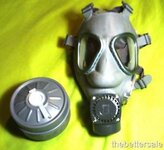This is going to be a bit hard to explain in this forum. I'll try to put it real simple and still get the point across. Let me know if you get confused.
First, you can't and shouldn't mix cartridges, filters and masks from different manufacturers. Everything needs to be from one manufacturer in order to meet the certification standards from NIOSH (US) or other approving agency (anywhere else). You also can't put parts from one mask model onto another, even if they are from the same manufacturer. I've seen a few that will interchange, but you are asking for trouble by doing this as you may not be fully protected.
The cartridges have a finite volume capacity. I'm going to use a ficticious example, so don't worry about the actual sizes, etc. Say a cartridge has the capacity of 8 ounces (240 ml for you Chris!) of material that absorbs non-specific organic vapors. (organics are compounds that have carbon atoms in them) In order to put some other material in the cartridge to remove something else from the air, you will have to remove some of the OV absorbing material. There are lots of overlaps in what the filtering materials can absorb so it is not a direct one for one exchange. Most of the absorbants in the cartridges are non-specific to a compound, so they will absorb lots of other things in the air as well. Something else to keep in mind is that some compounds can actually block another from absorbing on its specific absorbant so there is never a way to tell how effective the material is working at removing what you specifically want and how long it will continue to work. Even moisture in the air can absorb onto the absorbant and reduce its capacity. That is why you need to keep the cartridges in a sealed plastic bag when not being used as they continue to absorb compounds in the air whether you are using them or not, thus reducing the capacity and life. That is why air purifying respirator cartridges should not be used for compounds that don't have adequate warning properties like an odor or taste. You just can't tell when they are actually at or near their capacity to absorb. This is not real critical in the hobby situation for most compounds, but could be life threatening in an industrial situation. And they should NEVER be used where there may not be enough oxygen in the air. It won't help if you are filtering the caontaminant from the air you breath if there is not enough oxygen content to keep you alive.
As to the filters, there is a system that defines how efficient a filter is at removing particles in the air and whether it can be used where there are oil mists in the air. to make it easier, here is a link to a chart that describes the system for you. Non-US users will need to convert the NIOSH designations to their system, but the meanings are essentially the same.
http://www.cdc.gov/niosh/npptl/topics/respirators/disp_part/
Each manufacturer has a different system for attaching filters to their cartridges and some attach the filters permanently. In the hobby situation like ours, it is usually better to have separate filters as they will clog up with dust before the capacity of the absobant is reached. And don't try to get cheap and clean them, replace with new filters.
Hope this didn't confuse anyone. You can PM me if you have specific questions.

